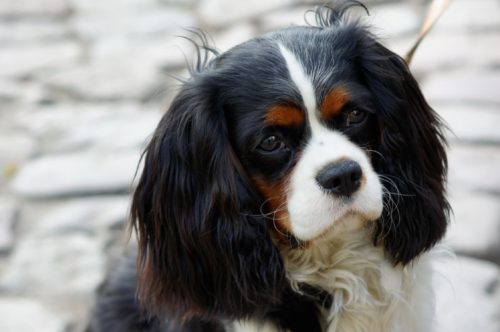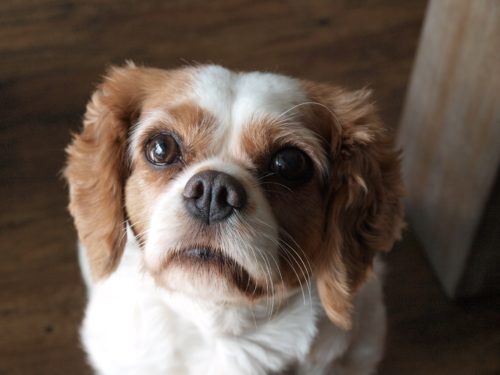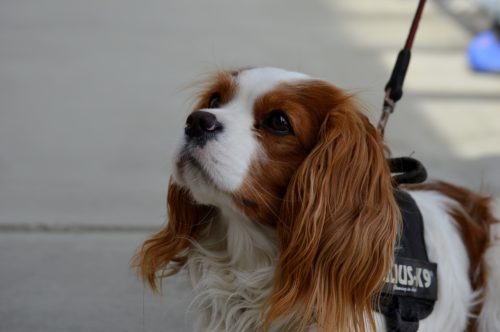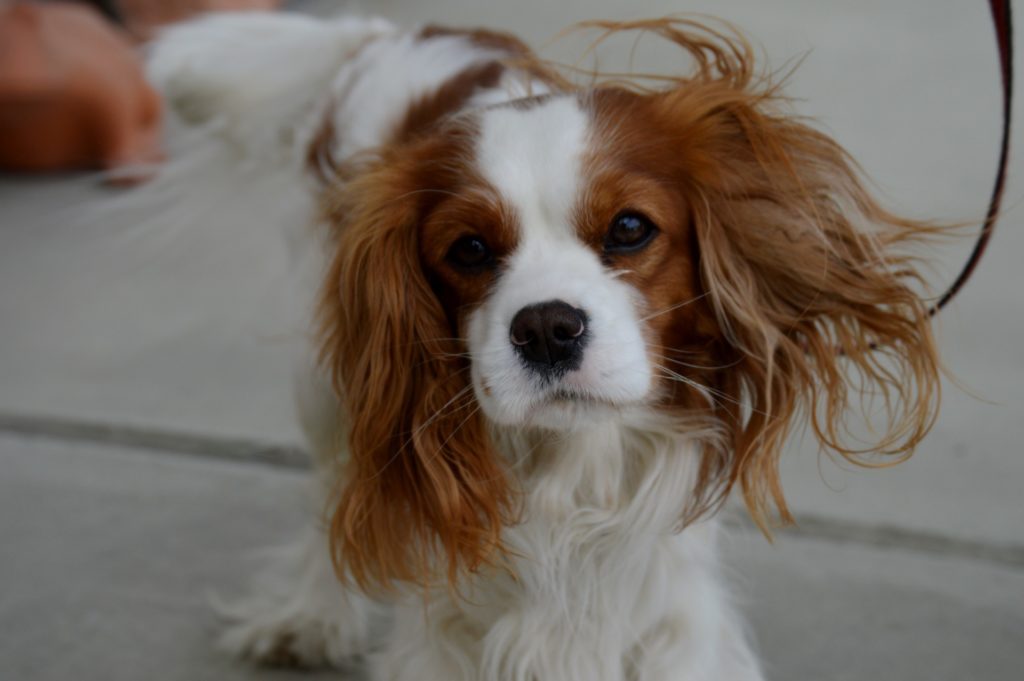Cavalier King Charles Spaniels are trustworthy, friendly, easy to train, and a great addition to any family. They need a moderate amount of exercise and are perfectly happy taking naps indoors or going long walks with their owners. The Cavalier dog breed has a high-maintenance coat that requires brushing and grooming on a regular basis in order to keep them feeling and looking their best. If you’re considering adopting a Cavalier King Charles Spaniel, read about their specific grooming requirements here.
Appearance
Cavalier King Charles Spaniels are a small dog breed. They have large eyes with soft cushioning underneath, giving them a gentle expression. Cavaliers have long, furry ears and wavy coats. The breed comes in a variety of colors including black and tan, solid ruby, Blenheim (chestnut and white), and tricolor. Cavalier King Charles Spaniels have a feathered chest as well as feathering on their legs and feet.

Size
Cavalier King Charles Spaniels are usually between 12 and 13 inches tall and weigh between 12 and 18 pounds. Some male Cavaliers can weigh up to 25 pounds. The breed is slightly longer than it is tall but has a somewhat square proportion.
Coat
The coat of a Cavalier King Charles Spaniel is medium in length. Their hair is wavy and silky with some feathering. The most common color of Cavaliers is Blenheim, in which case they will typically have a small chestnut-colored dot on their forehead.
This breed is known to shed quite a bit, so potential owners should be aware of this and ready to find a significant amount of dog hair on their clothes and furniture.
Grooming Needs
The unique coat of the breed is susceptible to matting and tangling, which requires regular dog grooming. However, with the right tools and planning, Cavalier King Charles Spaniels can be relatively easy to maintain.
Brushing
Cavalier King Charles Spaniels are double-coated and require brushing about every other day. This will prevent tangles and remove any loose hair from their coat. Brushing can be done with a soft bristle brush or a comb. Cavalier King Charles Spaniels owners should focus on the feathered parts of their coat, specifically the ears and legs, which easily become tangled and matted. The knotted hair on a dog’s legs and feet can make it difficult for them to walk on hard floors or other slippery surfaces.
Most owners will choose to trim the hair on the top of their feet, but careful brushing will prevent tangling and tripping. Cavalier King Charles Spaniels are known for being lap dogs. Because of this, many owners may take a lap cuddle as an opportunity to brush their coat out.
When brushing, you will need to lift their outer coat in order to get to the hair underneath. It may also be helpful to positively reinforce a grooming session with treats and praise. Brushing will also keep a Cavalier King Charles Spaniel looking clean and fluffy and is also a good way to prevent knots during bathing.
Bathing
Cavalier King Charles Spaniels should be bathed only as necessary. For most Cavaliers, this is about once a month. However, active dogs who spend a lot of time outdoors will require more baths.
The oils in their undercoats of the breed create a water-resistant fur. Because of this, they will need to be shampooed twice. The first shampoo will break down the oils on their coat, while the second will remove them. Since washing removes the oils, bathing them too frequently will dry out their skin.
It’s important to use a shampoo that is specifically formulated for dogs. Cavalier dogs can be bathed in a kitchen sink. Lukewarm water should be used to wet the coat, followed by a lather in shampoo. The coat should then be rinsed, and they should be shampooed once more. After the second shampoo, dog conditioner can be applied to the coat and rinsed thoroughly afterward.
Avoid getting shampoo in their eyes when giving them a bath and be sure to take extra care when rinsing them off, as any soap or conditioner that is not completely rinsed out can irritate their skin.
If you have trouble keeping your Cavalier King Charles Spaniel calm and obedient during a bath, it may be a good idea to bathe him in a bathtub instead of a sink. To prevent your pup from slipping, be sure place a small towel or rubber mat on the bottom of the sink or tub. This will keep them more at ease during bath time.

Drying
After a bath, your Cavalier King Charles Spaniel’s coat should be gently patted down with a towel. This will prevent him from shaking water onto the floor. Be careful not to rub your dog’s coat too much as this can create tangles.
A Cavalier’s coat can be dried with a blow dryer on the lowest setting. While drying, some owners like to feather their dog’s hair with a comb or brush. Proper drying will prevent skin irritation that can arise from residual dampness.
Trimming
The feathered fur on a Cavalier King Charles Spaniel’s feet is longer than other parts of its coat. In order to prevent tripping or difficulty walking, it is recommended to trim the hair between the pads on the bottom of their feet.
Electric clippers can be used to trim this fur, but some may opt to have a professional groomer do the job. It’s important to check the feet of your Cavalier King Charles Spaniel on a daily basis for tangles or stuck debris.
Clipping
Clipping of the fur is not allowed for Cavalier King Charles Spaniels that perform in shows. If you don’t plan to show your dog, his coat can be trimmed to about an inch in length. This will make it easier to groom your dog, but can result in his hair to grow back thicker and sometimes curly, which will require future clipping to keep it tidy.
Dental Hygiene
Cavalier King Charles Spaniels are born without teeth. As puppies, their teeth will begin to grow in at about around 4 or 5 weeks of age. Their baby teeth will be fall out and be replaced with adult teeth when they are about 4 months old. Brushing your Cavalier King Charles Spaniel’s teeth on a regular basis will not only freshen his breath but protect him from dental disease.
Without proper dental hygiene, dogs are at risk for developing plaque and gum disease. Additionally, bacteria in the mouth can travel to the bloodstream and lead to canine kidney problems or other infections. In addition to brushing your dog’s teeth, good quality chews can be helpful for keeping his mouth clean and healthy.

Ear Care
The floppy, feathered ears on Cavalier King Charles Spaniels are subject to various infections. To prevent this, an ear-cleaning solution designed specifically for dogs can be applied to cotton balls to clean out the insides of their ears about once a week.
Owners should check the inside their dog’s ears for bacterial and fungal infections which may give off an odor. If you notice any signs of a canine ear infection, such as redness or irritation, check in with a veterinarian.
Trimming the hair on the inside of the ears can help to improve airflow and prevent infections. Consult with your veterinarian if you notice that your Cavalier has signs of an ear infection.
A Groomed Dog is a Healthy Dog
Responsible Cavalier King Charles Spaniel owners will be knowledgeable about the unique grooming needs of their pet and prepared to keep them clean and healthy. If the grooming process is started when they’re a puppy, they will become accustomed to the routine and less resistant to brushing and bathing. As puppies, their coats are fairly short, making grooming easier for you as well as them while they get used to the idea.
When grooming your dog, remember to check for rashes, cuts, sores, excess dryness, or signs of infection. A regular examination during grooming will help owners spot potential health issues early on. For general grooming of a Cavalier King Charles Spaniel, a comb, soft brush, nail clippers, ear-cleaning solution, and dog shampoo should be kept on hand. If you choose to take your Cavalier King Charles Spaniel to a professional groomer, you should first inquire whether they have worked with the breed in the past.
This is particularly important if you plan to show your dog, as there are strict rules about trimming and the length of their coats. When developing a grooming routine for your Cavalier, keep in mind that all dogs are unique and will prefer a different technique. Additionally, they will change as they age. If you are patient, gentle, and flexible with your pet, he will respond with good behavior during grooming and may even look forward to baths and brushing.




